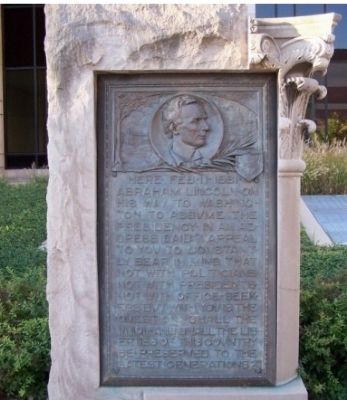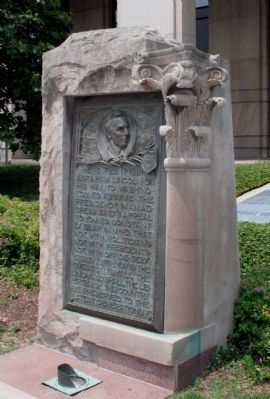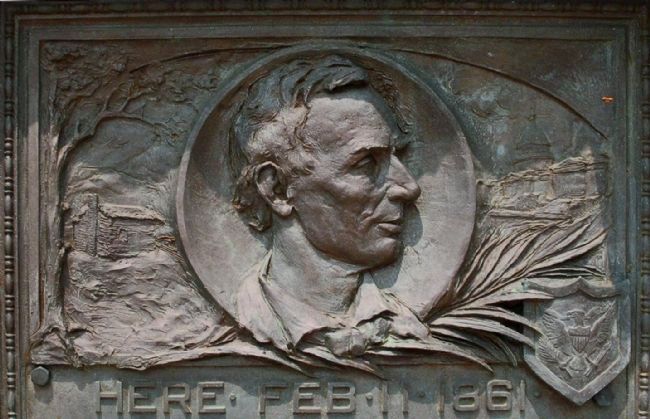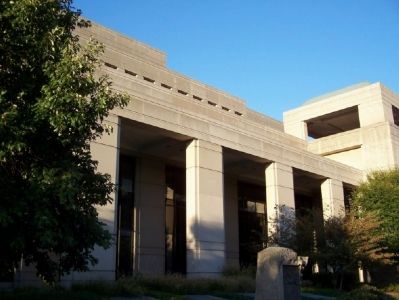Mile Square in Indianapolis in Marion County, Indiana — The American Midwest (Great Lakes)
Here, Abraham Lincoln Said
Topics and series. This historical marker is listed in these topic lists: Patriots & Patriotism • Railroads & Streetcars • War, US Civil. In addition, it is included in the Former U.S. Presidents: #16 Abraham Lincoln, and the Lincoln 1861 Inaugural Train Stops series lists. A significant historical month for this entry is February 1913.
Location. 39° 46.045′ N, 86° 9.908′ W. Marker is in Indianapolis, Indiana, in Marion County. It is in Mile Square. Marker is at the intersection of West Washington Street (U.S. 40) and South Missouri Street, on the right when traveling west on West Washington Street. Touch for map. Marker is at or near this postal address: 402 W Washington Street, Indianapolis IN 46204, United States of America. Touch for directions.
Other nearby markers. At least 8 other markers are within walking distance of this marker. Lincoln to the Citizens of Indiana (a few steps from this marker); Historic National Road / Make History, Drive It (about 400 feet away, measured in a direct line); Macedonian Tribune (about 500 feet away); Robert D. Orr, 1917-2004 (about 500 feet away); Bicentennial Tree Planting 2017 (about 600 feet away); Christopher Columbus (about 600 feet away); 9/11 Memorial (about 600 feet away); Bicentennial Moon Tree (about 700 feet away). Touch for a list and map of all markers in Indianapolis.
Related markers. Click here for a list of markers that are related to this marker.
Also see . . . Lincoln Plaque. Smithsonian Institution Research Information System. (Submitted on March 23, 2015, by Allen C. Browne of Silver Spring, Maryland.)
Additional commentary.
1. President Lincoln’s 1861 Train Journey to His Inauguration
Excerpt from Chapter XII in the 1902 book A Short Life of Abraham Lincoln by John G. Nicolay
Having completed his arrangements, Mr. Lincoln started on his journey [from Springfield] to Washington on February 11, 1861, on a special train, accompanied by Mrs. Lincoln and their three children, his two private secretaries, and a suite of about a dozen personal friends. Mr. Seward had suggested that in view of the feverish condition of public affairs, he should come a week earlier; but Mr. Lincoln allowed himself only time enough comfortably to fill the appointments he had made to visit the capitals and principal cities of the States on his route, in accordance
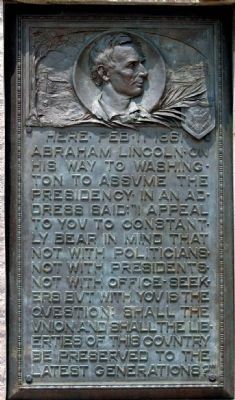
Photographed By Allen C. Browne, May 29, 2007
2. Lincoln Plaque
This plaque was originally designed by Marie Stewart a student at Shortbridge High School and sculpted by Rudolf Schwartz. It was originally placed on Feb. 12, 1907 at the Claypool Hotel (at the corner of Illinois and Washington Streets), site of the historic Bates House where Lincoln stayed in 1861. The Claypool Hotel was demolished in 1969. The plaque was reinstalled in the current location on a new base designed by Benno Shum and rededicated on Feb. 12, 1971.
“My friends: No one, not in my situation, can appreciate my feeling of sadness at this parting. To this place, and the kindness of these people, I owe everything. Here I have lived a quarter of a century, and have passed from a young to an old man. Here my children have been born, and one is buried. I now leave, not knowing when or whether ever I may return, with a task before me greater than that which rested upon Washington. Without the assistance of that Divine Being who ever attended him, I cannot succeed. With that assistance, I cannot fail. Trusting in Him who can go with me, and remain with you, and be everywhere for good, let us confidently hope that all will yet be well. To His care commending you, as I hope in your prayers you will commend me, I bid you an affectionate farewell.”
It was the beginning of a memorable journey. On the whole route from Springfield to Washington, at almost every station, even the smallest, was gathered a crowd of people
in hope to catch a glimpse of the face of the President-elect, or, at least, to see the flying train. At the larger stopping-places these gatherings were swelled to thousands, and in the great cities into almost unmanageable assemblages. Everywhere there were vociferous calls for Mr. Lincoln, and, if he showed himself, for a speech. Whenever there was sufficient time, he would step to the rear platform of the car and bow his acknowledgments as the train was moving away, and sometimes utter a few words of thanks and greeting. At the capitals of Indiana, Ohio, New York, New Jersey, and Pennsylvania, as also in the cities of Cincinnati, Cleveland, Buffalo, New York, and Philadelphia, a halt was made for one or two days, and a program was carried out of a formal visit and brief address to each house of the legislature, street processions, large receptions in the evening, and other similar ceremonies; and in each of them there was an unprecedented outpouring of the people to take advantage of every opportunity to see and to hear the future Chief Magistrate of the Union.
Party foes as well as party friends made up these expectant crowds. The public suspense was at a degree of tension which rendered every eye and ear eager to catch even the slightest indication of the thoughts or intentions of the man who was to be the official guide of the nation in a crisis the course and end
of which even the wisest dared not predict. In the twenty or thirty brief addresses delivered by Mr. Lincoln on this journey, he observed the utmost caution of utterance and reticence of declaration; yet the shades of meaning in his carefully chosen sentences were enough to show how alive he was to the trials and dangers confronting his administration, and to inspire hope and confidence in his judgment. He repeated that he regarded the public demonstrations not as belonging to himself, but to the high office with which the people had clothed him; and that if he failed, they could four years later substitute a better man in his place; and in his very first address, at Indianapolis, he thus emphasized their reciprocal duties:
“If the union of these States and the liberties of this people shall be lost, it is but little to any one man of fifty-two years of age, but a great deal to the thirty millions of people who inhabit these United States, and to their posterity in all coming time. It is your business to rise up and preserve the Union and liberty for yourselves and not for me. . . . I appeal to you again to constantly bear in mind that not with politicians, not with Presidents, not with office-seekers, but with you, is the question, Shall the Union and shall the liberties of this country be preserved to the latest generations?”
Many salient
and interesting quotations could be made from his other addresses, but a comparatively few sentences will be sufficient to enable the reader to infer what was likely to be his ultimate conclusion and action. In his second speech at Indianapolis he asked the question:
“On what rightful principle may a State, being not more than one-fiftieth part of the nation in soil and population, break up the nation, and then coerce a proportionally larger subdivision of itself in the most arbitrary way?”
At Steubenville: “If the majority should not rule, who would be the judge? Where is such a judge to be found? We should all be bound by the majority of the American people—if not, then the minority must control. Would that be right?”
At Trenton: “I shall do all that may be in my power to promote a peaceful settlement of all our difficulties. The man does not live who is more devoted to peace than I am, none who would do more to preserve it, but it may be necessary to put the foot down firmly.”
At Harrisburg: “While I am exceedingly gratified to see the manifestation upon your streets of your military force here, and exceedingly gratified at your promise to use that force upon a proper emergency—while I make these acknowledgments, I desire to repeat, in order to preclude any possible misconstruction, that I do most sincerely hope that we shall have no use for them; that it will never become their duty to shed blood, and most especially never to shed fraternal blood. I promise that so far as I may have wisdom to direct, if so painful a result shall in any wise be brought about, it shall be through no fault of mine.”
While Mr. Lincoln was yet at Philadelphia, he was met by Mr. Frederick W. Seward, son of Senator Seward, who brought him an important communication from his father and General Scott at Washington. About the beginning of the year serious apprehension had been felt lest a sudden uprising of the secessionists in Virginia and Maryland might endeavor to gain possession of the national capital. An investigation by a committee of Congress found no active military preparation to exist for such a purpose, but considerable traces of disaffection and local conspiracy in Baltimore; and, to guard against such an outbreak, President Buchanan had permitted his Secretary of War, Mr. Holt, to call General Scott to Washington and charge him with the safety of the city, not only at that moment, but also during the counting of the presidential returns in February, and the coming inauguration of Mr. Lincoln. For this purpose General Scott had concentrated at Washington a few companies from the regular army, and also, in addition, had organized and armed about nine hundred men of the militia of the District of Columbia.
In connection with these precautions, Colonel Stone, who commanded these forces, had kept himself informed about the disaffection in Baltimore, through the agency of the New York police department. The communication brought by young Mr. Seward contained besides notes from his father and General Scott, a short report from Colonel Stone, stating that there had arisen within the past few days imminent danger of violence to and the assassination of Mr. Lincoln in his passage through Baltimore, should the time of that passage be known.
“All risk,” he suggested, “might be easily avoided by a change in the traveling arrangements which would bring Mr. Lincoln and a portion of his party through Baltimore by a night train without previous notice.”
The seriousness of this information was doubled by the fact that Mr. Lincoln had, that same day, held an interview with a prominent Chicago detective who had been for some weeks employed by the president of the Philadelphia, Wilmington and Baltimore railway to investigate the danger to their property and trains from the Baltimore secessionists. The investigations of this detective, a Mr. Pinkerton, had been carried on without the knowledge of the New York detective, and he reported not identical, but almost similar, conditions of insurrectionary feeling and danger, and recommended the same precaution.
Mr. Lincoln very earnestly debated the situation with his intimate personal friend, Hon. N.B. Judd of Chicago, perhaps the most active and influential member of his suite, who advised him to proceed to Washington that same evening on the eleven-o’clock train. “I cannot go to-night,” replied Mr. Lincoln; “I have promised to raise the flag over Independence Hall to-morrow morning, and to visit the legislature at Harrisburg. Beyond that I have no engagements.”
The railroad schedule by which Mr. Lincoln had hitherto been traveling included a direct trip from Harrisburg, through Baltimore, to Washington on Saturday, February 23. When the Harrisburg ceremonies had been concluded on the afternoon of the 22d, the danger and the proposed change of program were for the first time fully laid before a confidential meeting of the prominent members of Mr. Lincoln’s suite. Reasons were strongly urged both for and against the plan; but Mr. Lincoln finally decided and explained that while he himself was not afraid he would be assassinated, nevertheless, since the possibility of danger had been made known from two entirely independent sources, and officially communicated to him by his future prime minister and the general of the American armies, he was no longer at liberty to disregard it; that it was not the question of his private life, but the regular and orderly transmission of the authority of the government of the United States in the face of threatened revolution, which he had no right to put in the slightest jeopardy. He would, therefore, carry out the plan, the full details of which had been arranged with the railroad officials.
Accordingly, that same evening, he, with a single companion, Colonel W. H. Lamon, took a car from Harrisburg back to Philadelphia, at which place, about midnight, they boarded the through train from New York to Washington, and without recognition or any untoward incident passed quietly through Baltimore, and reached the capital about daylight on the morning of February 23, where they were met by Mr. Seward and Representative Washburne of Illinois, and conducted to Willard's Hotel.
When Mr. Lincoln’s departure from Harrisburg became known, a reckless newspaper correspondent telegraphed to New York the ridiculous invention that he traveled disguised in a Scotch cap and long military cloak. There was not one word of truth in the absurd statement. Mr. Lincoln’s family and suite proceeded to Washington by the originally arranged train and schedule, and witnessed great crowds in the streets of Baltimore, but encountered neither turbulence nor incivility of any kind. There was now, of course, no occasion for any, since the telegraph had definitely announced that the President-elect was already in Washington.
— Submitted October 2, 2006.
Credits. This page was last revised on September 14, 2023. It was originally submitted on October 2, 2006, by M. Bowyer of Indianapolis, Indiana. This page has been viewed 3,532 times since then and 19 times this year. Last updated on November 29, 2007, by Christopher Light of Valparaiso, Indiana. Photos: 1. submitted on October 2, 2006, by M. Bowyer of Indianapolis, Indiana. 2, 3, 4. submitted on March 23, 2015, by Allen C. Browne of Silver Spring, Maryland. 5. submitted on October 2, 2006, by M. Bowyer of Indianapolis, Indiana. • J. J. Prats was the editor who published this page.
